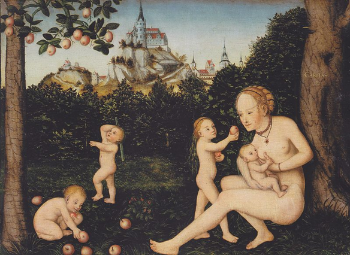During the Renaissance, the standard iconographic image of Christian love shows a mother accompanied by three or four children. The youngest child is at the mother’s breast, the others are nourished by that other Mother: Nature. Neither room nor square, rather nature is the usual context in which caritas is pictured.
Is it not strange that caritas/agape is not performed as, for instance, a social attitude expressing the state of ‘divine sociability (Augustine’s civitas dei), or as an act obeying the commandment of neighborly love? In the 15th and 16th century, Christian love is imaged by a female nude with children symbolizing Nature – already in the sense the word will obtain with Jean-Jacques Rousseau: the original environment supplying human beings in all their needs. Nature considered as maternal generosity, source of limitless gift-giving.
Lucas Cranach the Younger, Caritas, ca 1550
It is difficult not to see in Caritas’ image as a mother a resemblance to that other renaissance icon of the mother, the one with a single child: the image of the Virgin Mary. The difference, however, is striking. In the latter, generosity is central as well, but precisely not a natural one. It is not Nature who has given a child to the mother, but God. The child is begotten, not by a natural, sexual act, but by an ‘unnatural Word’, the Word of Revelation coming from outside Nature, revealing the One who was already there before Creation and is able, in his limitless generosity, to restore the mistakes incurred to that Creation after Adam’s fall.
Giovanni Boltraffio, Madonna lactans, ca 1508
In the Caritas image, the woman is gift-giving in the active sense of the word. In the icon of the ‘Madonna with child’, too, the woman is performed as giver, as Theotokos, the one who gave birth to the Savior. Yet, rather than the agency, she is both the addressee and the medium of the gift-giving at work here. Mother Mary has been given a child. She is the icon of ‘passive’ susceptibility, of a womb willing to conceive God’s incarnation. Instead, Caritas is an actively gift-giving woman. Rather than a womb, she is a source never drying up.
Caritas/agape, ‘technical’ term for the overcoming of the Old Covenant’s Law, indicates the core of Christianity as the acme of monotheistic revelation. It anticipates the situation after the ‘End of Time’ and gives a taste of how things will be after the Apocalypse, after the destruction of Nature as it is now. And, yet, in Renaissance iconography, Caritas is represented by Nature as it is now, Nature as the generosity of vitalistic and earthly life.
Is this contradictory?
Not according to people living in Renaissance Europe. Since God has been incarnated in the natural state of the human, Nature is full of God. Which is why the intellectuals of that time see God present almost in a similar way as the Romans supposed their gods the be citizens of their city. This is why a Renaissance man easily confuses the Christian God with antique gods. Of course, he too does not believe that God coincides with nature, but since God is incarnated in it, every natural phenomenon is pregnant of the divine – and not only pregnant: it manifests God’s real birth, his incarnation.
So, Nature itself has become the incarnation of God’s ultimate revelation. This is why the difference between the image of Mother Caritas is perfectly in line with the one of Mother Mary. The incarnation which occurred in Mary implies the liberation of Nature which is now no longer marked by lack, sin and death. Nature has become an eternal source of generosity. Mother Caritas is the ‘active’ side of the coin that has Mother Mary on its ‘passive’ side.
This is why the Caritas image anticipates in a sense our post-Christian times. For if Nature is that in which God is incarnated, it is at same time that in which the incarnated God has been buried.
Raphael, Pope Urban I between Iustitia and Caritas, 1520-24
But even as God’s grave, Nature beholds similar characteristics. Remember Rousseau whose Nature keeps all features of the Christian paradise. When he emphasizes that Nature is “immémorablement perdu”, that term takes over the eschatological, apocalyptical reservation with which the Christian idea of an agape community has been preached.
Mother Caritas supposes Nature to be already the eternal realm of Love beyond sin and death. But one needs Mother Mary to understand that Nature has not yet passed the Eschaton, that the realm of fully realized agape is still to be expected.
The double Mother figure illustrates the basic ‘double bind’ of the Christian narrative: at the same time living in the land of Love beyond the Law and living that Love as a Law.
*



